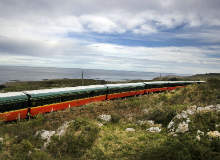
Spain’s railways have received priority status over the past ten years in a bid to improve land connectivity between the country’s biggest cities.
The motivation behind what has been a sustained investment in the rail sector has had part-economic, part-political justifications: the government’s aim was to build a fast, modern and reliable web of public transportation that would link the country’s main financial centres, thus stimulating free movement and business growth.
How well do you really know your competitors?
Access the most comprehensive Company Profiles on the market, powered by GlobalData. Save hours of research. Gain competitive edge.

Thank you!
Your download email will arrive shortly
Not ready to buy yet? Download a free sample
We are confident about the unique quality of our Company Profiles. However, we want you to make the most beneficial decision for your business, so we offer a free sample that you can download by submitting the below form
By GlobalDataIn May, Development Minister Ana Pastor revealed “the largest investment in suburban services on the national network for over 20 years”, a bold €1.26bn plan described by her as “very ambitious, but at the same time within our reach”. The project, together with a €3.56bn expansion of its high-speed railways planned for this year, is aimed at balancing the books and incentivising greater connectivity.
According to CIA’s World Factbook statistics from 2014, Spain has over 16,101km in tracks, divided into broad, standard and narrow gauge. State operator RENFE is responsible for the provision of passenger and freight transportation, under the supervision of the Ministry of Public Works and Transport.
In January 2005, under guidance from the European Railway Sector Act promoting free competition on the public transportation network, RENFE was divided into two distinct branches: Renfe Operadora became the owner of trains and rolling stock, working in direct competition with other railway companies, while Administrador de Infraestructuras Ferroviarias (ADIF) became the national infrastructure manager, responsible for the administration of rail infrastructure, distribution of railway capacity and collection of fees.
Presently, railways are receiving huge support both internally and from the EU. On a national level, over the past two years the state budget has dedicated the lion’s share of funding towards building and modernising the railway sector, with the trend continuing into 2016. Additional support from the EU in accord with Europe’s transportation strategy will further contribute to Spain achieving its 2020 vision of a fully coordinated, state-of-the-art railway system.
Spain’s railways secure state and EU funding
Spain’s long-term commitment to railway expansion appeared on the agenda in 2004 with the launch of its Strategic Plan of Infrastructures and Transport (PEIT), a national funding programme stretching until 2020.
The development scheme began out of the government’s recognition of “uneven quality of domestic rail infrastructure and service, low levels of traffic on some routes, difficulties harmonizing operations with other European railways, and conflicts between rail and urban development”, according to the Worldwatch website. Putting transport at its core, PEIT called for 44% of the total investment to be dedicated to rail, with an emphasis on high-speed lines.
In April 2010, Spain announced a €17bn investment in transportation, 70% of which went towards rail. High-speed rail tracks received €7.4bn in 2010 alone, Worldwatch noted.
According to the ‘Strategic Infrastructures and Transport Plan PEIT’ report, “the aim of the activity in the rail system is to convert it progressively into the central element for the structuring of intermodal transport services for both passengers and goods.”
“This principle makes it necessary to focus action in corridors where demand and potential is greatest so that, in coordination with regional rail and bus services, countrywide accessibility can be improved,” the document reads.
The 2015 federal budget further reflected these ambitions: out of a €9.5bn state funding for the Development Group, which oversees all areas of transportation, railways received €5.1bn, a share of 54%. This is a 13% increase on the previous year and the large majority of it, almost 70%, went towards high-speed development, followed by management and maintenance, rolling stock and improvements of the conventional network.
As Australia’s Inland Rail inches forward, leading transport firms have called on the government to step up its commitment.
Heavy investment is also pouring from abroad: Spain’s Mediterranean Corridor was identified amongst the nine core network corridors under EU’s TEN-T programme, a continent-wide project aiming to create the new backbone of transportation serving the European Single Market by 2030.
Key projects within both the Mediterranean and the Atlantic corridors earmarked for financing under EU’s Connecting Europe Facility include the construction of the Valencia – Tarragona – Barcelona line before 2020, the completion of the Barcelona – Perpignan cross-border section by the end of 2015 and the intermodal connection between Sines/Lisboa – Madrid high-speed lines with the region’s ports, just to name a few.
In August, Pastor announced that the 2016 budget will allocate over €19bn to the Ministry of Public Works and Transport, but with no clear specification of how much will be dedicated to the rail sector. A brief indication that the rail industry might be prioritised again was given by El Pais newspaper, which reported that “investment in the AVE [Spain’s high-speed railways] is set to increase 3.3% to €3.679bn in 2016”.
The challenge of declining demand and upcoming strikes
Spain’s railway system has not been without its problems, however. According to La Marea newspaper, the Secretary of International Relations at the Federal Railway Sector Esteban Guijarro decried the weak passenger demand along the country’s high-speed routes, saying that “all Spaniards have invested heavily in construction of high-speed lines as to not have even 50% of its capacity occupied”.
Furthermore, a damning new report published in March 2015 by research institution Applied Economy Studies Foundation (FEDEA) claimed that “not one of the [country’s high speed lines] should have been built” since none of them are registering a profit. Their 50 years’ worth of financial data showed that, currently, the Madrid-Barcelona corridor comes up €4.08bn short, the Madrid-Andalusia corridor €4.95bn short and the Madrid-Levante corridor €5.32bn short.
The lack of demand is not news, however, and the ministry has been committed to upping passenger levels in the past. For example, one of RENFE’s campaigns saw the operator launch a 70% discount on train tickets, which resulted in increased sales and a profit of €9m in 2014. According to El Pais, this aggressive pricing policy managed to narrow the gap in passenger demand between airlines and railway services at the start of 2015, since more passengers opted for train services compared to past years.
Furthermore, the €1.26bn suburban rail development is hoped to result in an additional 22 million passengers over the next three years, forecasts RENFE.
Currently, however, the rail sector is bracing for a series of strikes from RENFE train drivers in September. Semaf, the Spanish union of train drivers and workers, recently announced that a number of strikes will be taking place in September. The public action, taken due to “staffing and working conditions”, is expected to affect commuter and inter-city passenger trains, as well as some freight trains.
Despite the drawbacks, Spain’s rail expansion is an undeniable achievement: while just three years ago the country was undergoing the largest high-speed rail construction program in Europe, it now operates the longest high-speed network with 3,100km of track. This performance certainly sets a positive tone to the country’s ambition to achieve a 10,000km high-speed network by 2020.




